MediaTek RT3090BC4 802.11B/G/N 1T1R COMBO CARD User Manual
MediaTek Inc. 802.11B/G/N 1T1R COMBO CARD
MediaTek >
Contents
USER MANUAL
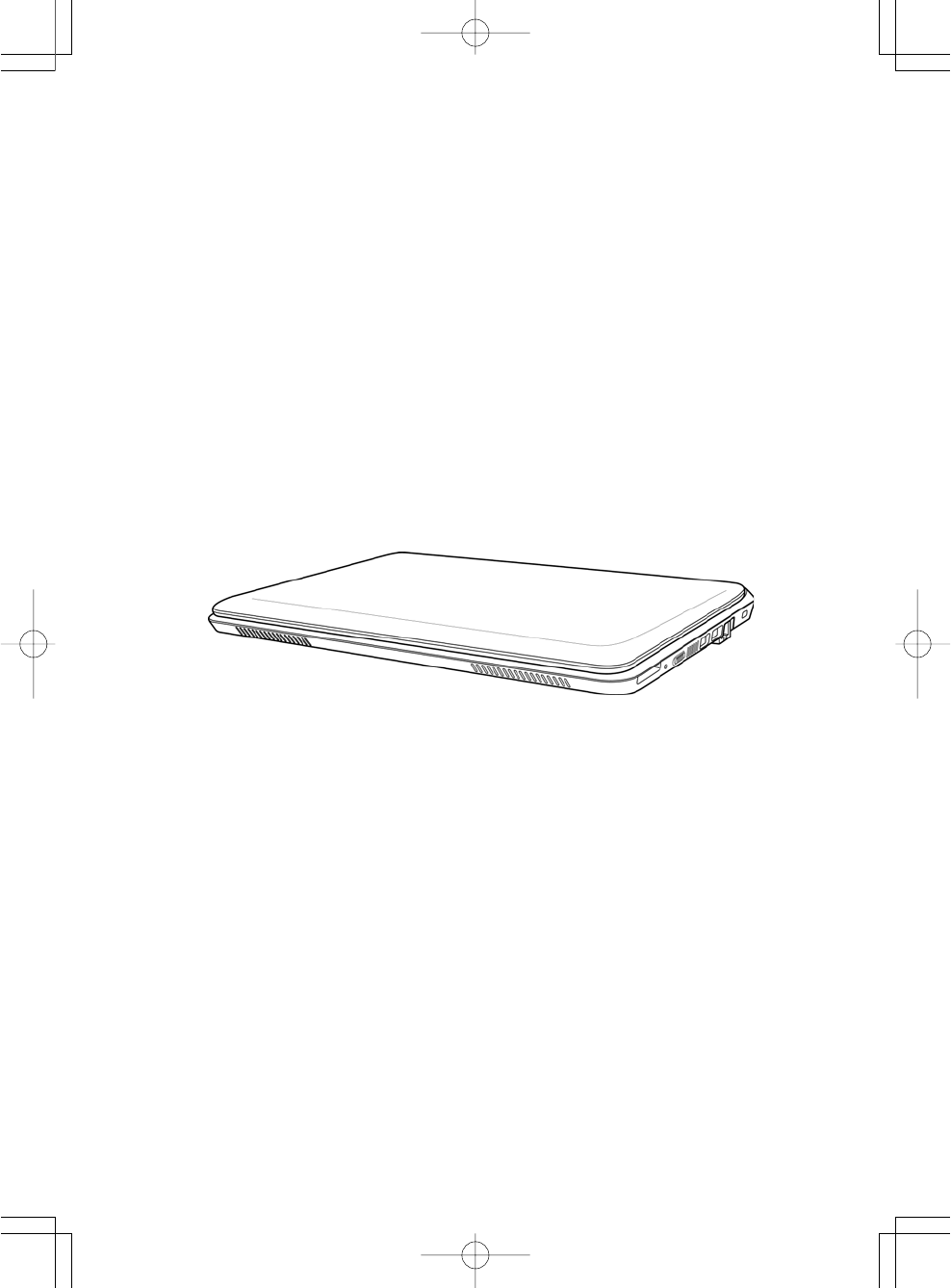
USER'S MANUAL
September 2010
ENGLISH
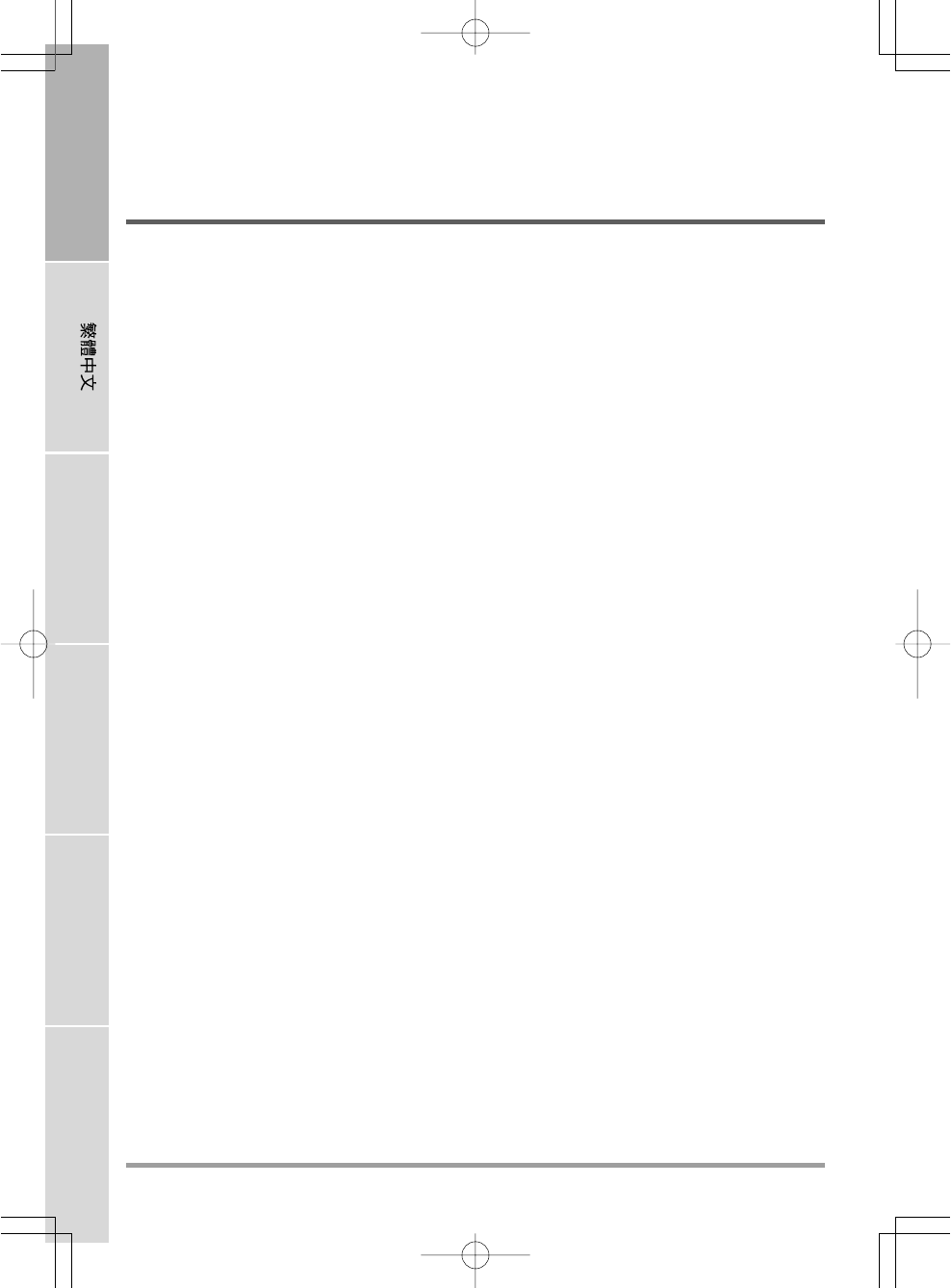
2
ENGLISH FRANÇAIS DEUTSCH ESPAÑOL ITALIANO
CONTENTS
BEFORE YOU START ............................................................................................. 5
Make sure you have everything ..................................................................................... 5
Familiarize yourself with the computer ........................................................................ 6
OPENING THE DISPLAY PANEL ................................................................................ 6
FRONT OVERVIEW .................................................................................................... 7
LEFT SIDE OVERVIEW .............................................................................................. 9
RIGHT SIDE OVERVIEW .......................................................................................... 10
BACK OVERVIEW ..................................................................................................... 11
BOTTOM OVERVIEW ................................................................................................ 12
GETTING STARTED ............................................................................................. 13
Power Sources ............................................................................................................. 13
CONNECTING THE POWER ADAPTER .................................................................. 13
PRESERVING BATTERY LIFE .................................................................................. 13
RECHARGING THE BATTERY ................................................................................. 14
BATTERY REPLACEMENT ...................................................................................... 14
Starting Your Notebook................................................................................................. 15
POWER ON .............................................................................................................. 15
Status Indicators ...................................................................................................... 16
Using Function Keys ................................................................................................ 18
Using the TouchPad................................................................................................. 19
TROUBLESHOOTING ........................................................................................... 20
Identifying the Problem................................................................................................. 20
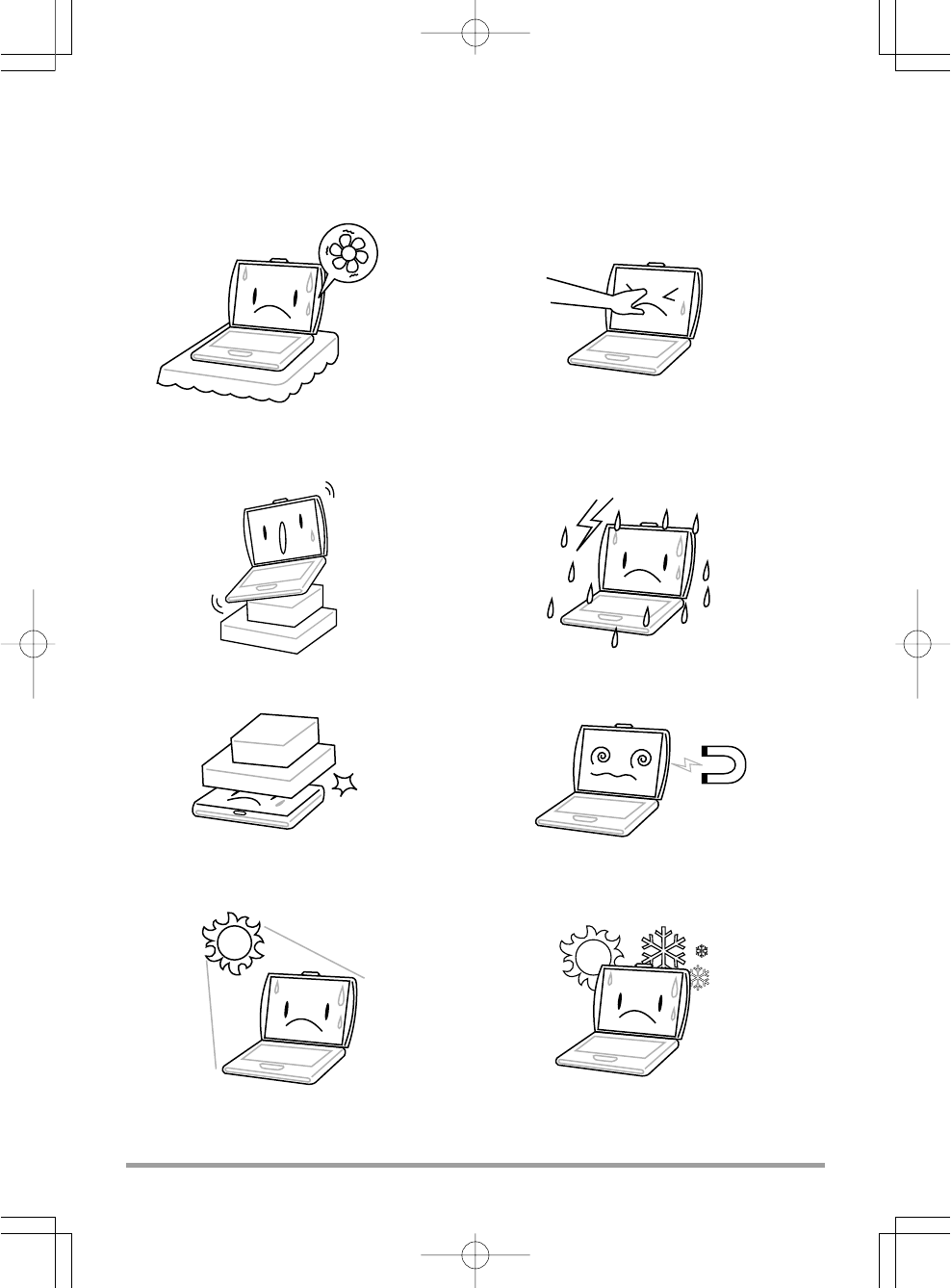
3
TAKING CARE OF YOUR NOTEBOOK PC
DO NOT place or drop objects on the computer
and DO NOT apply heavy pressure on it.
DO NOT subject the computer to magnetic
fields.
To prevent possible overheating of the computer's
processor, make sure you don't block the open-
ings provided for ventilation.
DO NOT press or touch the display panel.
DO NOT place on uneven or unstable work
surfaces.
DO NOT use your notebook computer under
harsh conditions.
DO NOT expose to direct sunlight. DO NOT use or store in extreme temperatures.
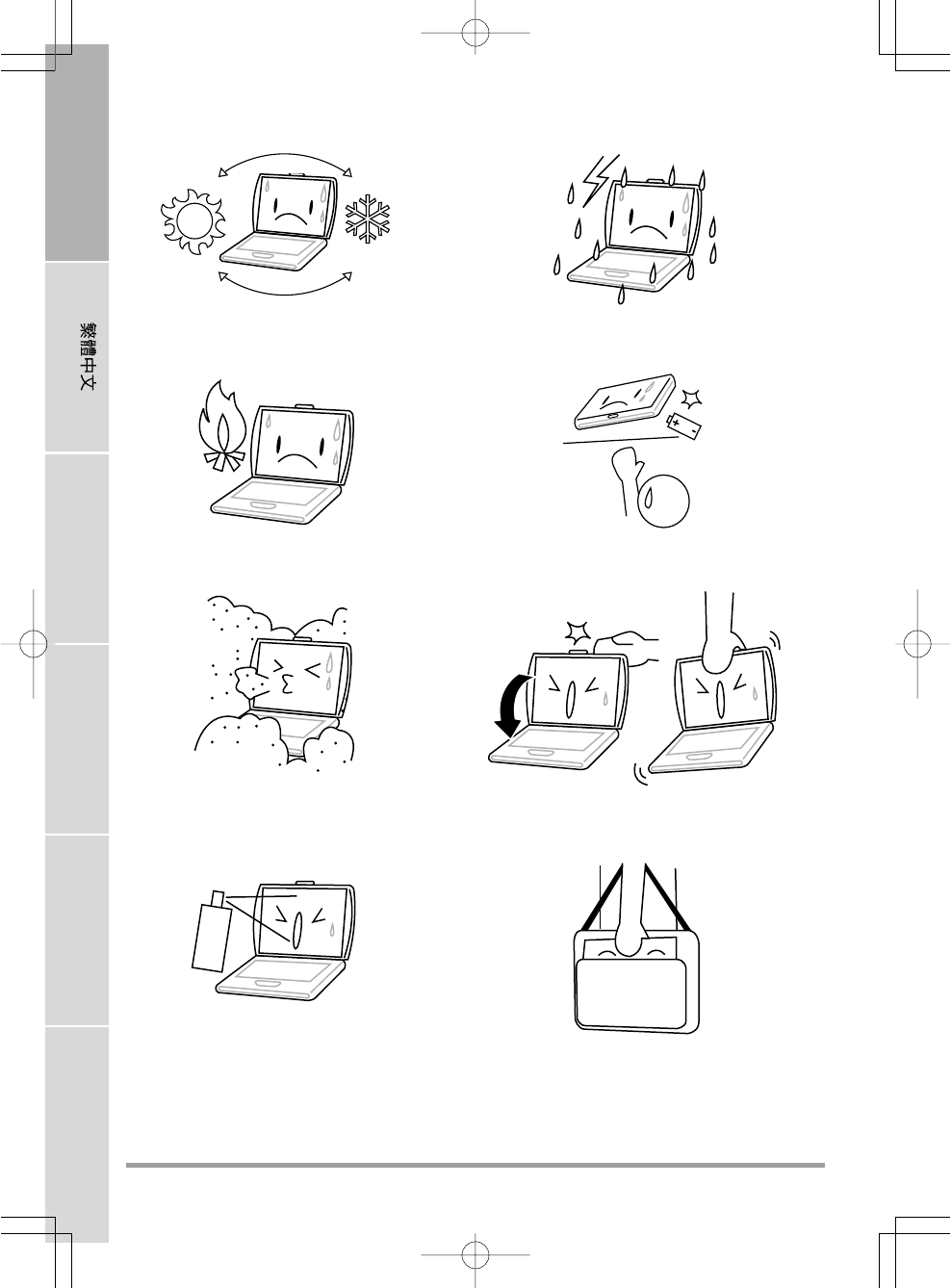
4
ENGLISH FRANÇAIS DEUTSCH ESPAÑOL ITALIANO
DO NOT expose to dust and/or corrosive
chemicals.
DO NOT spray water or any other cleaning fluids
directly on the display.
DO NOT slam your notebook shut and never
pick up or hold your notebook by the display.
If you are traveling with your computer, remem-
ber to carry it as hand luggage. Do not check it in
as baggage.
DO NOT place near fire or other sources of heat. DO NOT tamper with the batteries. Keep them
away from children.
Avoid sudden changes in temperature or humid-
ity by keeping it away from A/C and heating
vents.
DO NOT expose the computer to rain or
moisture.
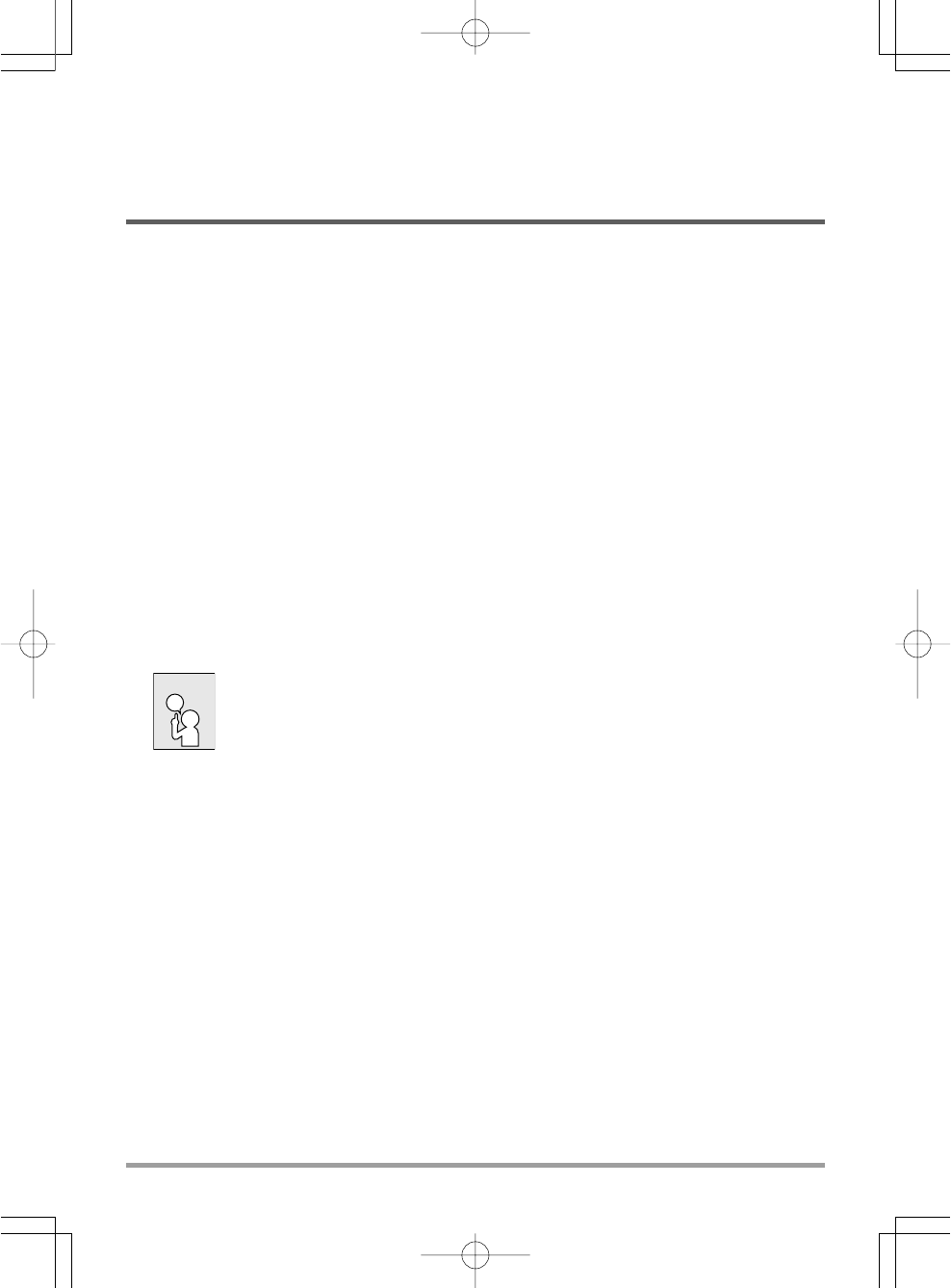
5
BEFORE YOU START
Make sure you have everything
When you receive your notebook PC, unpack it carefully and check to make sure you have all the
items listed below. For a pre-configured model you should have the following:
• Notebook Computer
• Lithium-Ion battery
• AC adapter with power cord
• Driver and Applications CD
• Quick Start Guide or User Guide
Depending on the configuration of your notebook, you may also need the following items:
• Dual DVD+/-RW Application Disc
• Super Multi DVD RW Application Disc
• Blu-ray/DVD RW Application Disc
Once you have checked and confirmed that your notebook system is complete, read through the
following pages to learn about all of your notebook components.
Depending on the model you purchased, the actual appearance of your note-
book may vary from that shown in this manual.
NOTE
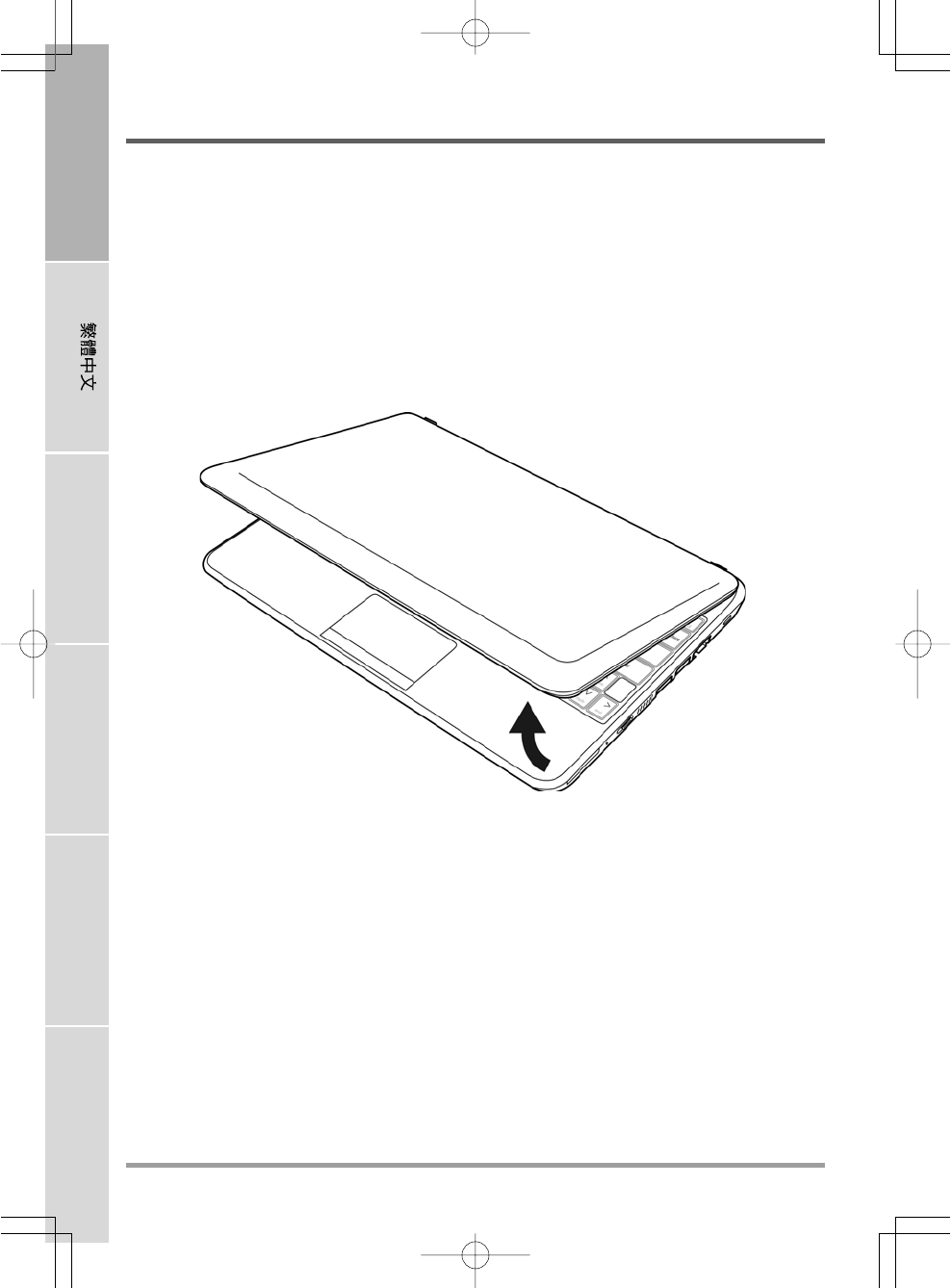
BEFORE YOU START
6
ENGLISH FRANÇAIS DEUTSCH ESPAÑOL ITALIANO
Familiarize yourself with the computer
OPENING THE DISPLAY PANEL
To open the display panel, simply lift the lid up.
When closing it, be sure not to slam it shut.
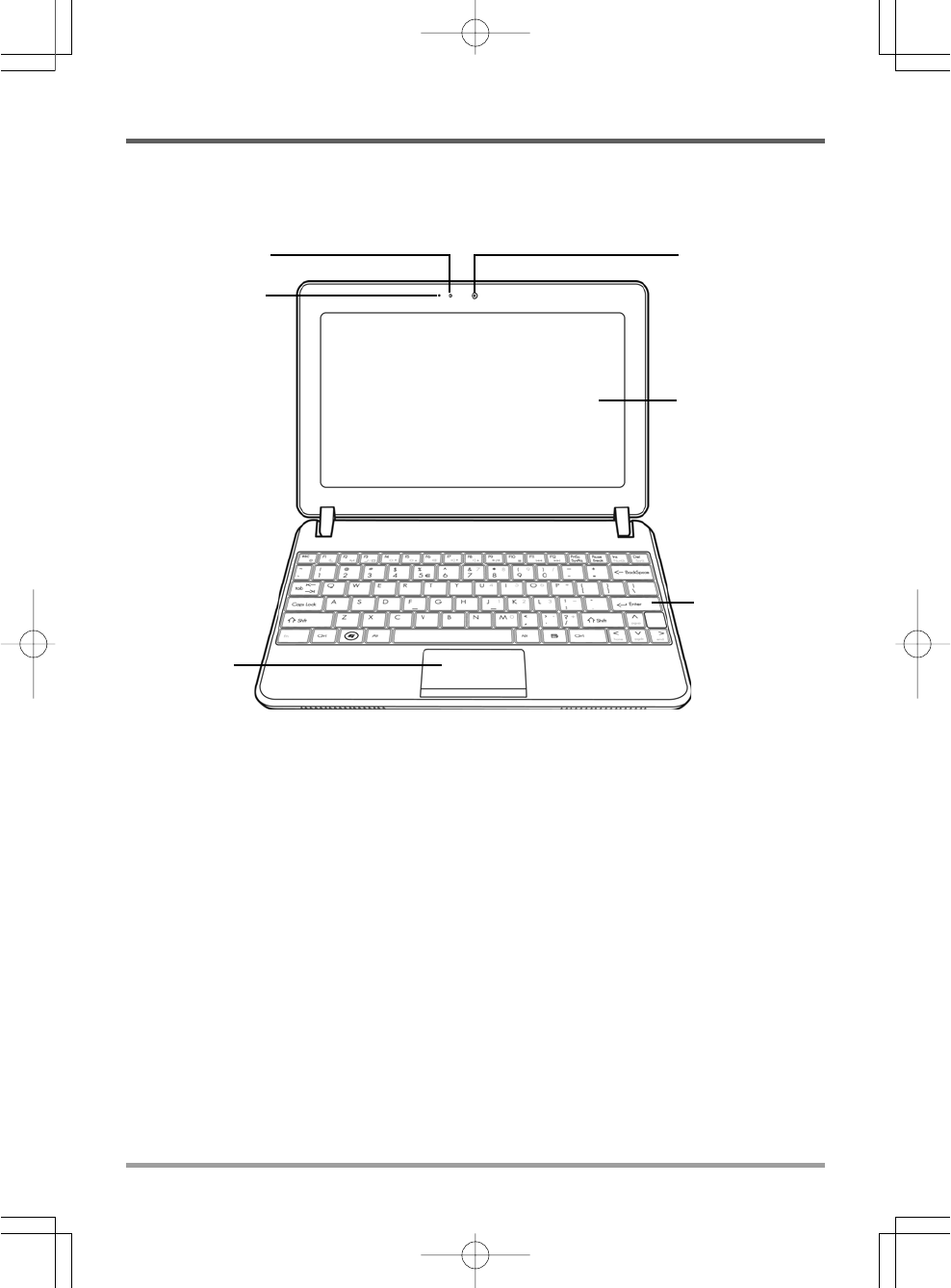
BEFORE YOU START
7
FRONT OVERVIEW
The following is an overview of the front of the notebook.
Microphone
The built-in microphone allows for the reception and transmission of voice and/or other audio
data to any program capable of accepting such input.
Camera Indicator
The Camera indicator lights up when the camera is activated.
Camera
The built-in 0.3 megapixel or 1.3 megapixel camera allows you to snap a photo or create a video
chat or video conference with just a click.
Display Panel
The display panel is a color LCD panel with back lighting for the display of text and graphics.
Microphone
Camera Indicator Camera
Display Panel
Keyboard
TouchPad
Pointing
Device
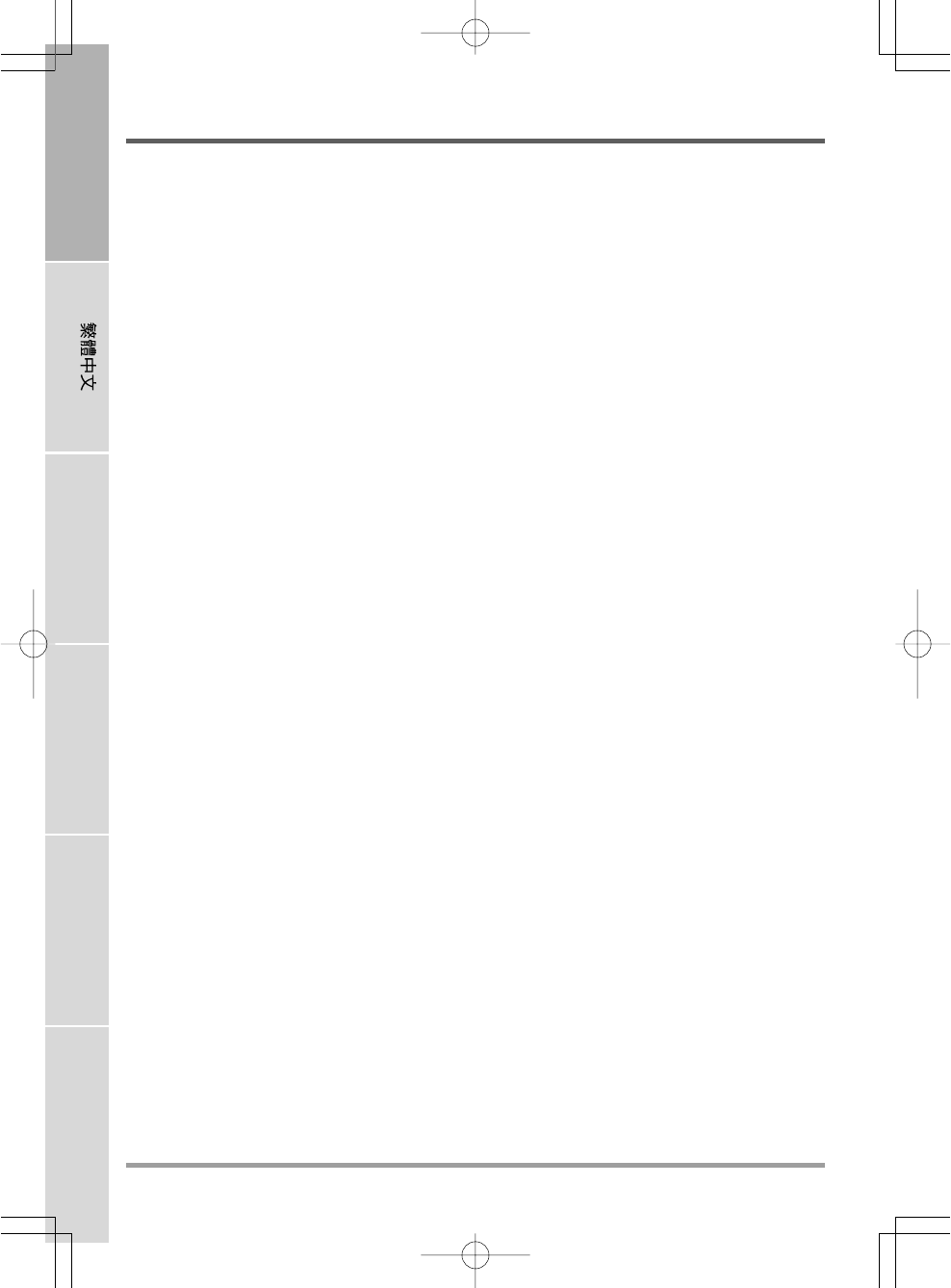
BEFORE YOU START
8
ENGLISH FRANÇAIS DEUTSCH ESPAÑOL ITALIANO
Keyboard
The keyboard comes with 82 keys, including dedicated Windows® keys.
TouchPad Pointing Device
The TouchPad pointing device is a mouse-like cursor control with two buttons and a touch
sensitive movement pad.
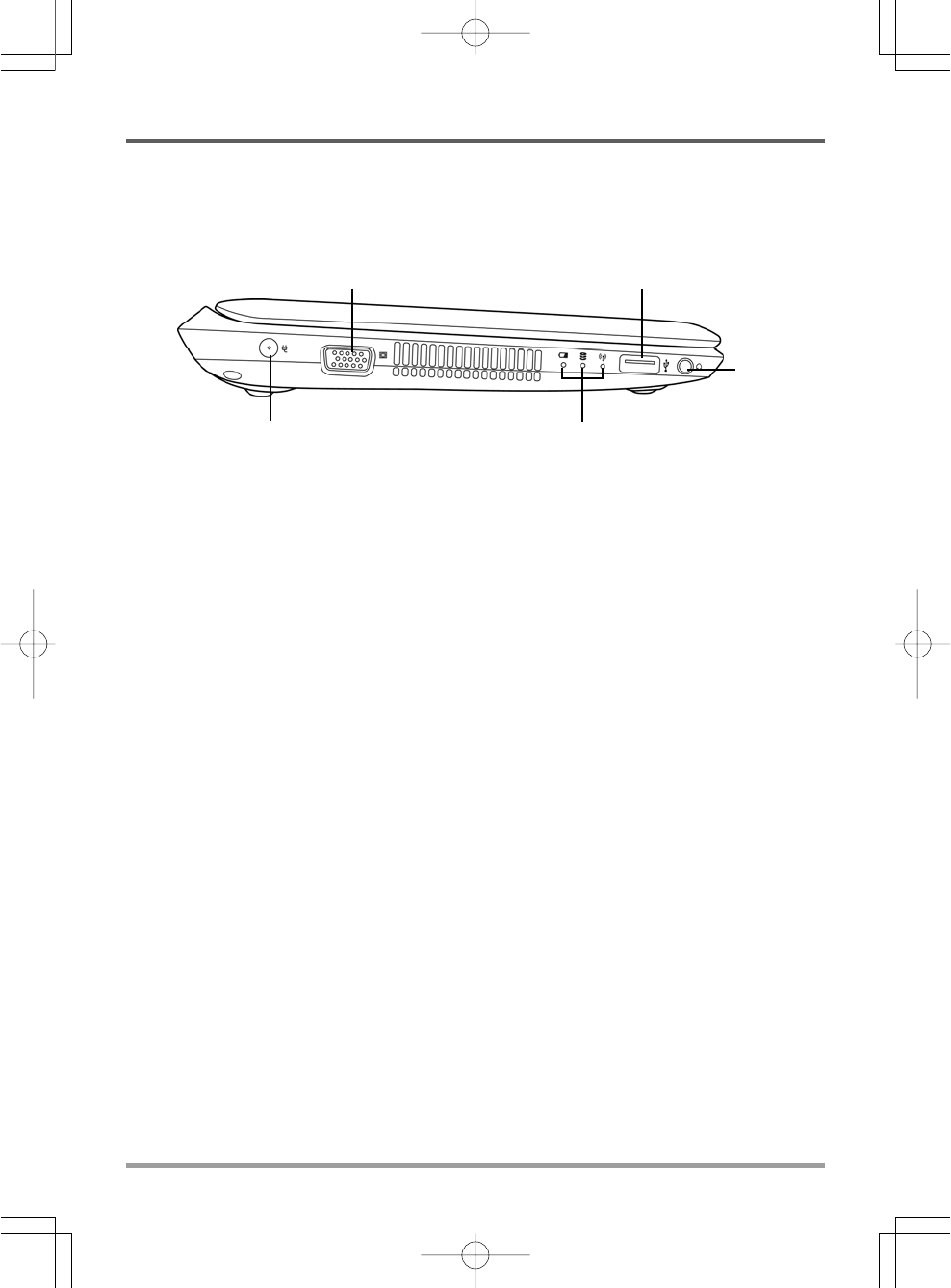
BEFORE YOU START
9
External Monitor Port
Power Adapter Port Status Indicator Lights
USB Port
Headphone
Jack
LEFT SIDE OVERVIEW
The following is a brief description of the left side of the notebook.
Power Adapter Port
The power adapter port allows you to plug in the AC adapter to power your notebook and charge
the internal Lithium-Ion battery.
External Monitor Port
The external monitor port allows you to connect an external monitor.
Status Indicator Lights
The Status indicator lights correspond to specific operating modes. These modes are: battery/AC
adapter status, hard drive activity (HDD) and wireless transmission activity.
USB Port
The USB port allows you to connect a Universal Serial Bus device. It supports v2.0 of the USB
standard, which allows data exchange rates as high as 480 Mb/s.
Headphone Jack
The headphone jack allows you to connect headphones or external speakers and amplifiers.
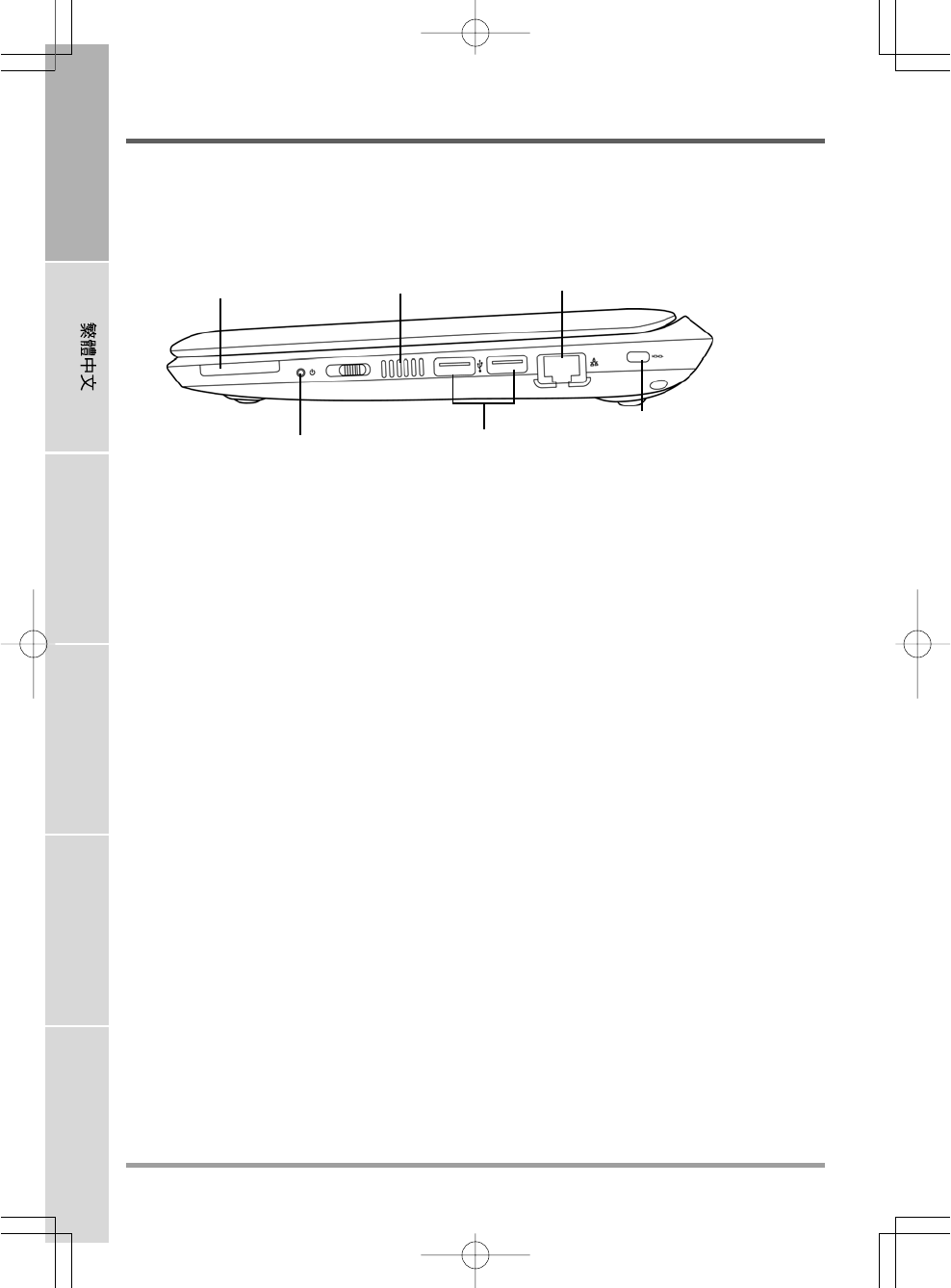
BEFORE YOU START
10
ENGLISH FRANÇAIS DEUTSCH ESPAÑOL ITALIANO
Memory Card Reader
The memory card reader offers the fastest and most convenient method to transfer pictures, music
and data between your notebook and flash compatible devices such as digital cameras, MP3
players, mobile phones, and PDAs.
Power On/Suspend Indicator
The light on the power button illuminates when the computer is powered on, and flashes when
the computer is in the Suspend mode.
Suspend/Power On Button
This button turns your notebook on and off or puts it to sleep. (See Suspend/Power On Button
in the Power On section for more information.)
USB Ports
The USB ports allow you to connect Universal Serial Bus devices. They support v2.0 of the USB
standard, which allows data exchange rates as high as 480 Mb/s.
LAN (RJ-45) Port
The LAN port is designed to support a 10/100 Base-TX standard RJ-45 plug.
RIGHT SIDE OVERVIEW
The following is a brief description of the right side of the notebook.
Suspend/Power On Button LAN (RJ-45) Port
USB Ports
Power On/Suspend Indicator
Kensington Lock Slot
Memory Card Reader
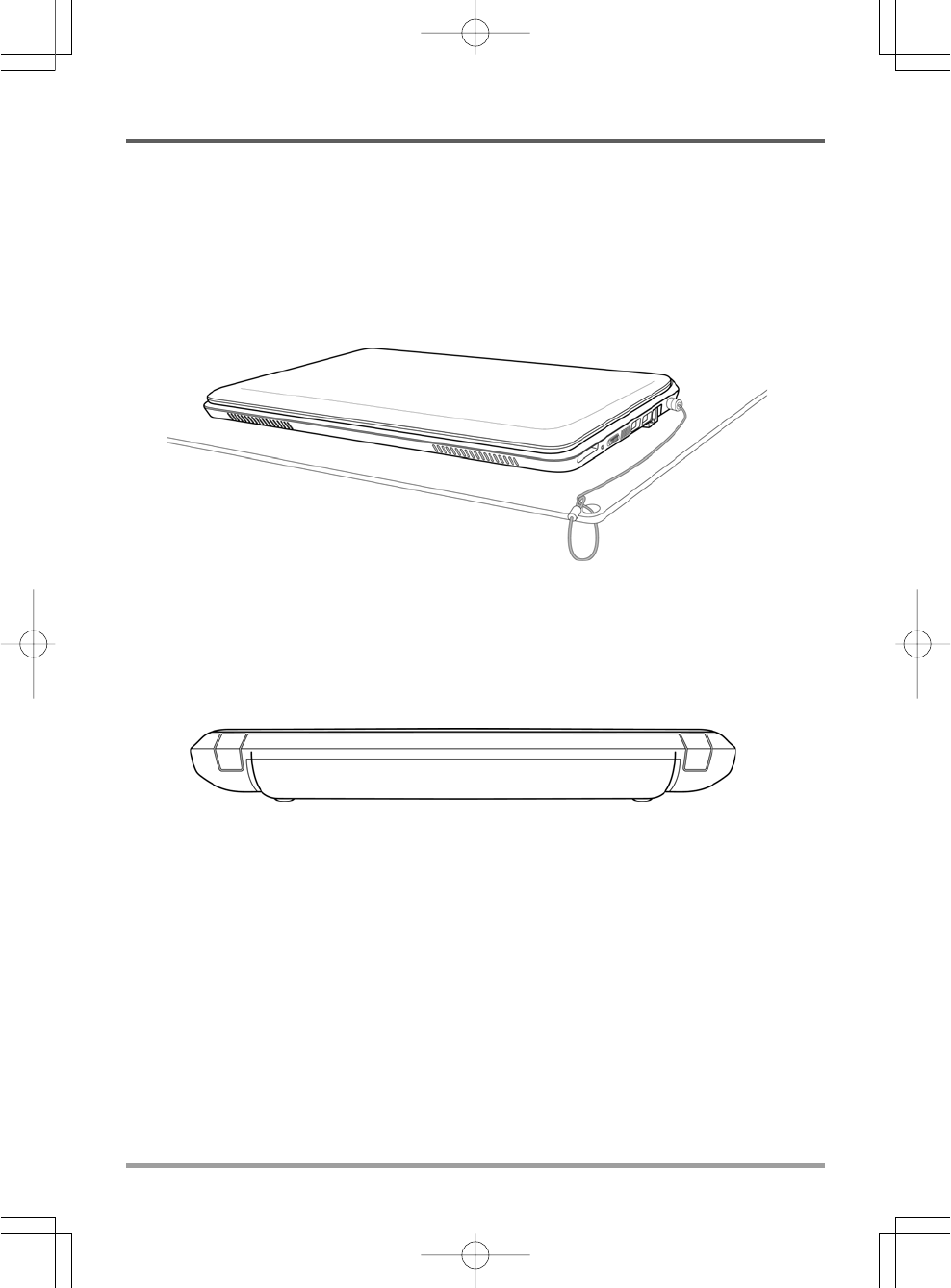
BEFORE YOU START
11
Kensington Lock Slot
The Kensington lock slot allows you to secure your notebook to an immovable object with an
optional security cable.
BACK OVERVIEW
The following is an overview of the back of the notebook.
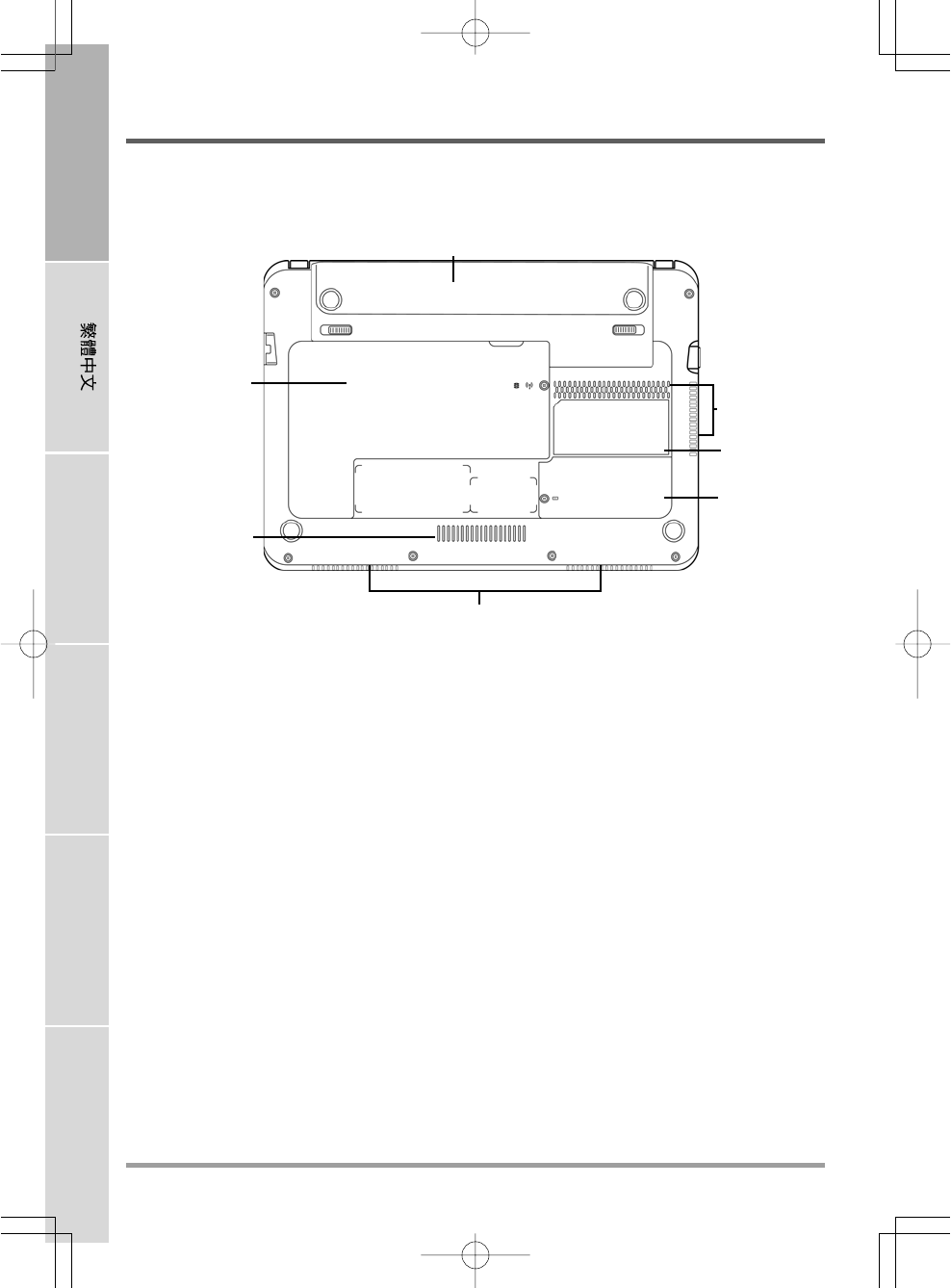
BEFORE YOU START
12
ENGLISH FRANÇAIS DEUTSCH ESPAÑOL ITALIANO
Stereo Speakers
Compartment
Cover
Lithium-Ion Battery Bay
Compartment
Cover
Rating Label
Fan Outlets
Fan Outlet
BOTTOM OVERVIEW
The following is an overview of the bottom of the notebook.
Lithium-Ion Battery Bay
The battery bay contains the internal Lithium-Ion battery. It can be opened for the removal of the
battery when stored over a long period of time or for swapping a discharged battery with a
charged Lithium-Ion battery.
Fan Outlets
These are open ports for the fans to dissipate heat from the computer's internal components. Do
not block or place the computer in such a position that you inadvertently allow the outlets to
become blocked.
Rating Label
The label shows the model number and other information about your notebook.
Compartment Covers
The 3G module compartment contains the 3G module (Not available in all configurations). The
memory compartment contains the computer's memory module.
Stereo Speakers
The built-in dual speakers allow for stereo sound.
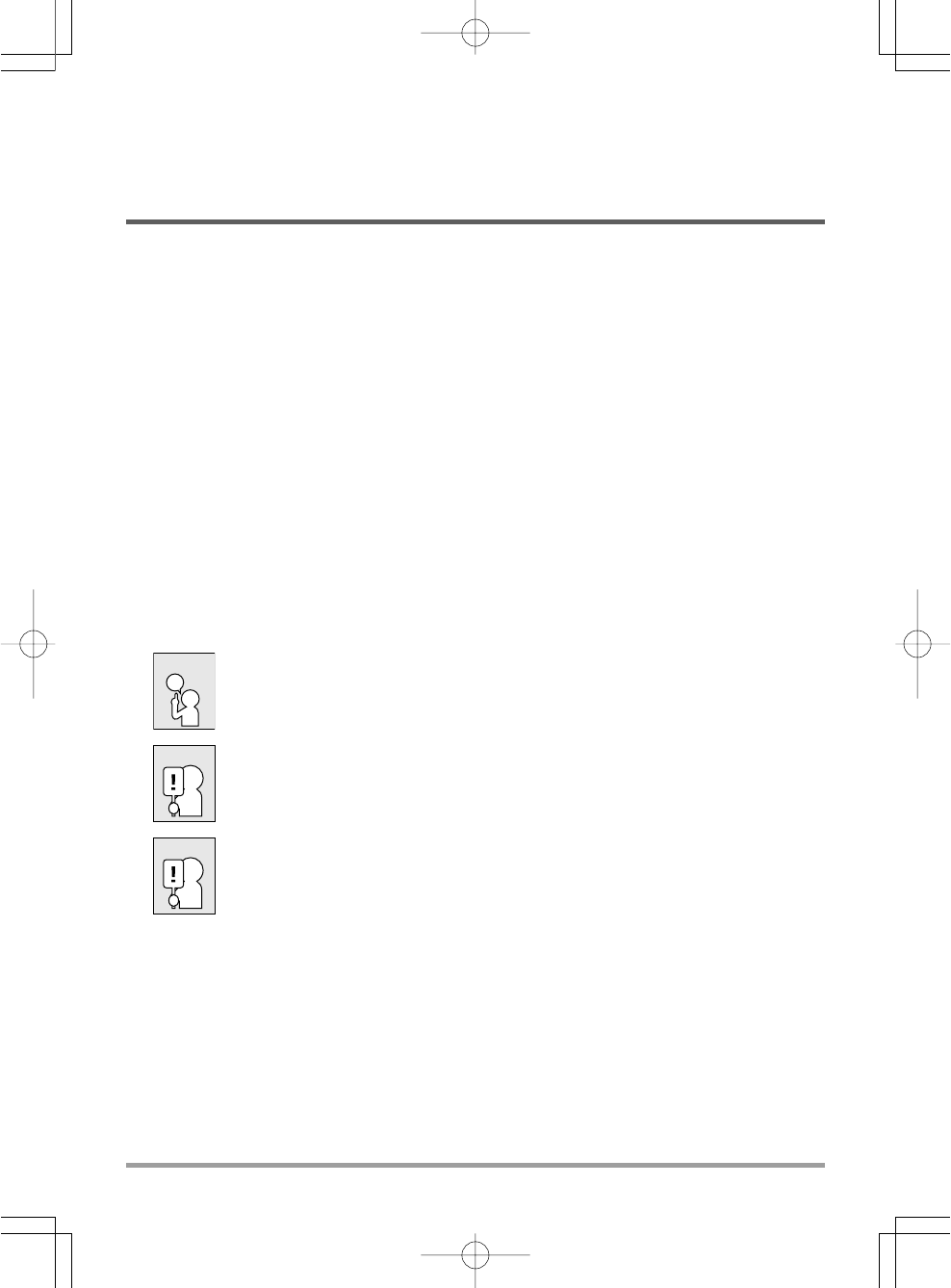
13
GETTING STARTED
Power Sources
Your computer has two types of power sources: a Lithium-Ion battery or an AC adapter.
CONNECTING THE POWER ADAPTER
The AC adapter provides power for operating your notebook PC and charging the battery.
Connecting the AC Adapter
1. Plug the DC output cable into the DC power jack of your notebook PC.
2. Plug the AC adapter into an AC electrical outlet.
Switching from AC Adapter Power to Battery Power
1. Be sure that you have at least one charged battery installed.
2. Remove the AC adapter. Your notebook will automatically switch from DC power to battery
power.
The Lithium-Ion battery is not charged upon purchase. Initially, you will need
to connect the AC adapter to use your notebook PC.
To protect your notebook from damage, use only Lithium-Ion batteries that
meet the specification. Improper use of batteries may lead to explosion and
bodily harm.
Do not dispose of batteries with household waste. Contact your local recycling
center or waste disposal operator to properly dispose of batteries according to
the local laws and regulations of your region.
PRESERVING BATTERY LIFE
• Fully discharge and recharge the battery every 30 days to prolong battery life.
• If the battery is not used for a month or longer, remove and store the battery in a cool, dry
place. Fully recharge the battery before using again.
NOTE
CAUTION
CAUTION
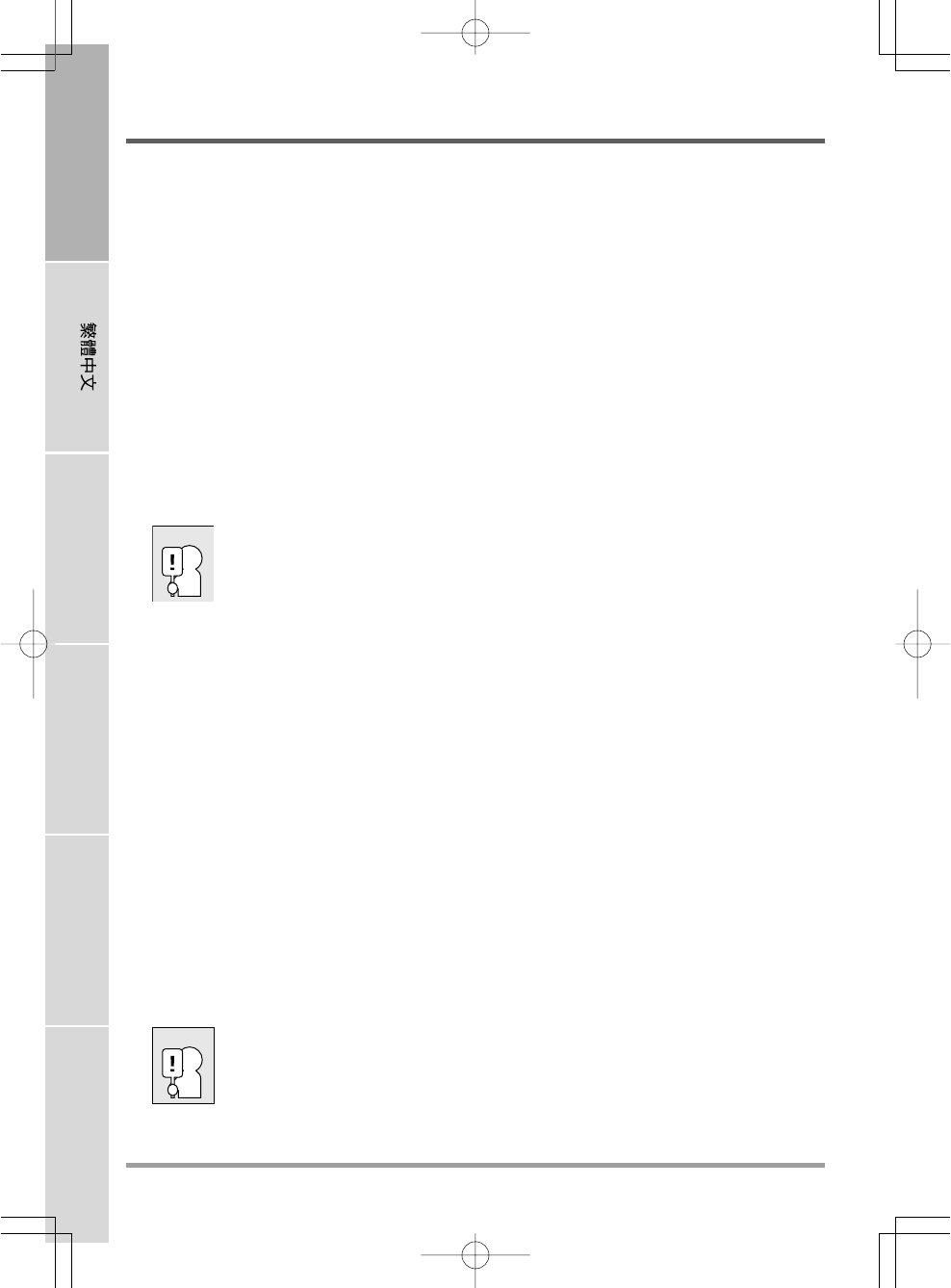
GETTING STARTED
14
ENGLISH FRANÇAIS DEUTSCH ESPAÑOL ITALIANO
RECHARGING THE BATTERY
The Lithium-Ion battery is recharged internally using the AC adapter. To recharge the battery,
make sure the battery is installed and the computer is connected to the AC adapter.
There is no "memory effect" in Lithium-Ion batteries; therefore you do not need to discharge the
battery completely before recharging. The charge times will be significantly longer if your note-
book is in use while the battery is charging. If you want to charge the battery more quickly, put
your computer into Suspend mode or turn it off while the adapter is charging the battery.
Low Battery State
When the battery charge is low, a notification message appears. If you do not respond to the low
battery message, the battery continues to discharge until it is too low to operate. When this
happens, your notebook PC goes into Suspend mode. There is no guarantee your data will be
saved once the notebook reaches this point.
To protect your notebook from damage, use only the power adapter that came
with it because each power adapter has its own power output rating.
Once your notebook goes into Suspend mode as a result of a dead battery, you will be unable to
resume operation until you provide a source of power either from an adapter or a charged battery.
Once you have provided power, you can press the Suspend/ Resume button to resume operation.
In Suspend mode, your data is maintained for some time, but if a power source is not provided
promptly, the Power indicator stops flashing and then goes out, in which case you have lost the
data that was not saved. Once you provide power, you can continue to use your computer while
an adapter charges the battery.
BATTERY REPLACEMENT
There is danger of explosion if an incorrect battery type is used for replacement. For computers
equipped with a replaceable lithium-ion battery pack, the following applies:
- if the battery is placed in an OPERATOR ACCESS AREA, there shall be a marking close to
the battery, or a statement in both the operating and the servicing instructions;
- if the battery is placed elsewhere in the computer, there shall be a marking close to the battery
or a statement in the servicing instructions.
The marking or statement shall include the following or similar text:
Risk of explosion if battery is replaced with an incorrect type. Dispose of used
batteries according to the instructions.
CAUTION
CAUTION
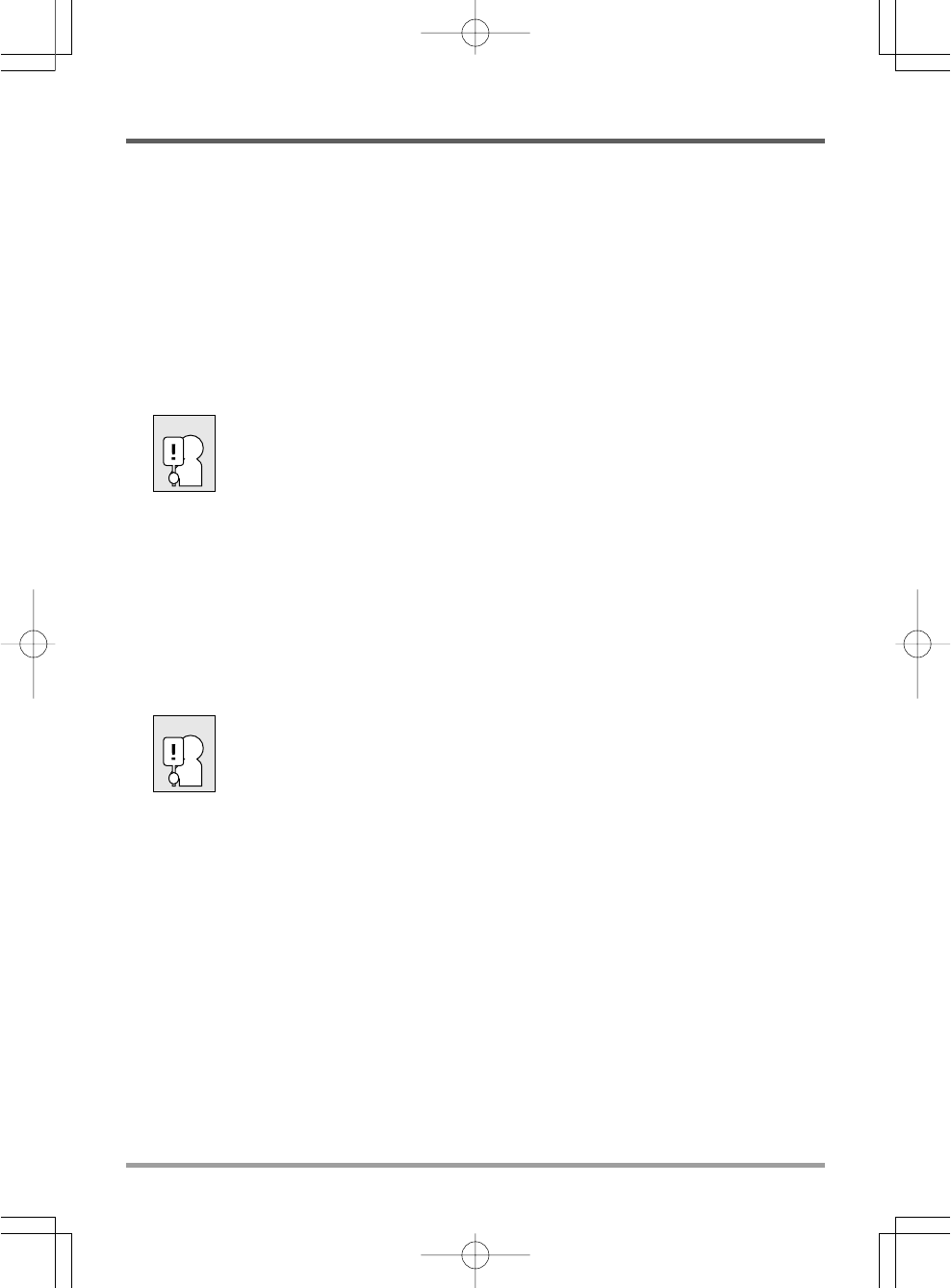
GETTING STARTED
15
Starting Your Notebook
POWER ON
Suspend/Power On Button
The suspend/power on button is used to turn on your notebook from its off state. Once you have
connected your AC adapter or charged the internal Lithium-Ion battery, you can power on your
notebook by pressing the suspend/power on button located above the keyboard. If you need to
take an extended break, press the button again to turn it off.
Do not carry your notebook around with the power on or subject it to shocks or
vibration, as you risk damaging the hard disk.
When you power on your notebook, it will perform a Power On Self Test (POST) to check the
internal parts and configuration for correct functionality. If a fault is found, your computer emits
an audio warning and/or displays an error message.
Depending on the nature of the problem, you may be able to continue by starting the operating
system or by entering the BIOS setup utility and revising the settings.
After satisfactory completion of the Power On Self Test (POST), your notebook loads the
installed operating system.
Never turn off your notebook during the Power On Self Test (POST), or an
unrecoverable error may occur.
CAUTION
CAUTION
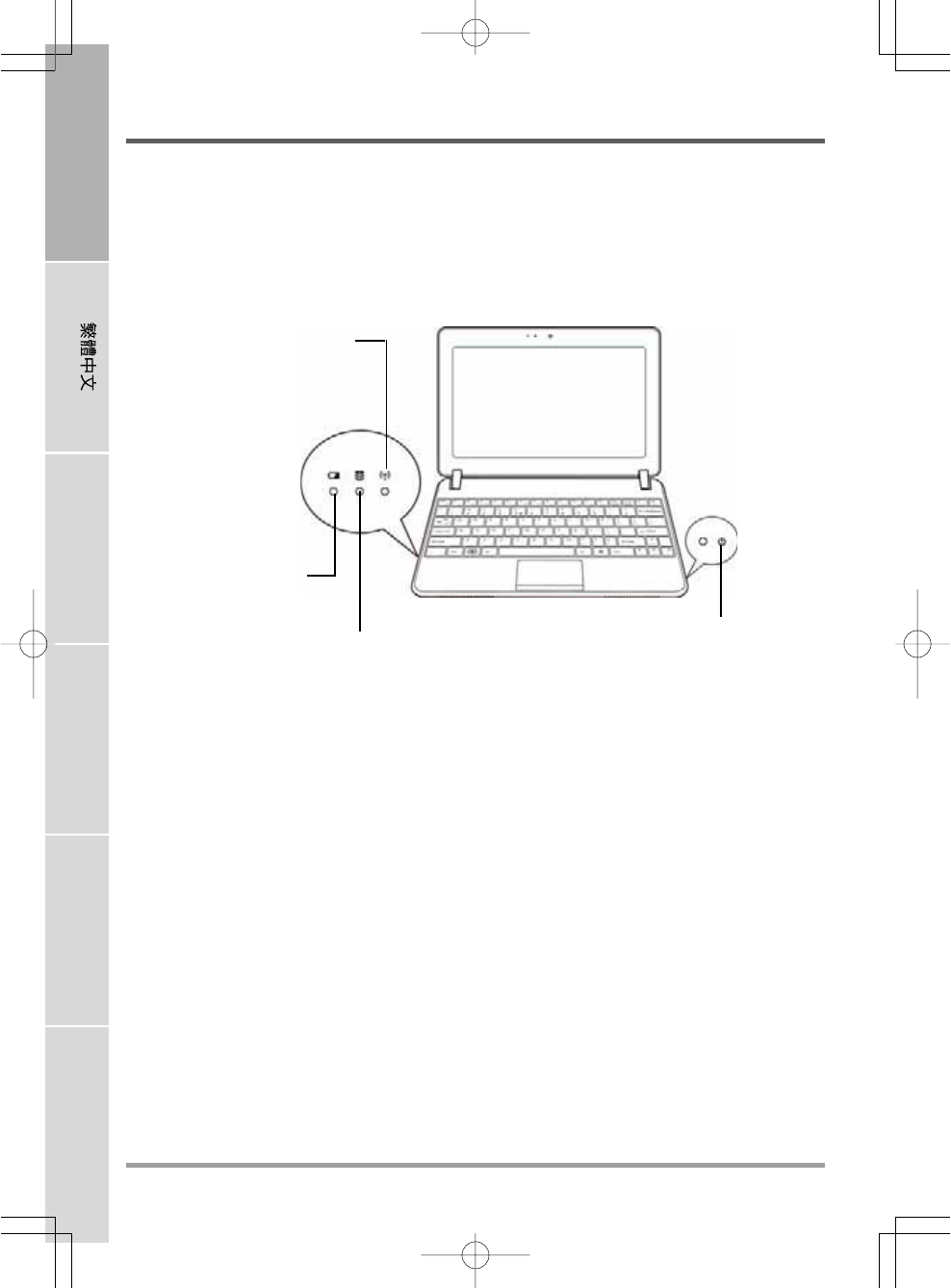
GETTING STARTED
16
ENGLISH FRANÇAIS DEUTSCH ESPAÑOL ITALIANO
Power On/Suspend Indicator
Battery Indicator
Hard Disk Drive (HDD) Activity
Indicator
Wireless Transmission Activity
Indicator
Status Indicators
The status indicator lights correspond to specific operating modes. These modes are: Power on/
Suspend status, Battery/AC adapter status, hard drive activity (HDD) and wireless transmission
activity.
Battery Indicator
The Battery indicator tells you whether the Lithium-Ion battery is charging or is already fully
charged.
• If you are charging your battery, the Battery indicator remains on even if your notebook is
shut off.
• If there is no battery activity, the power adapters are not connected, or the power switch is
Off, the Battery indicator will also be off.
• Batteries subjected to shocks, vibrations or extreme temperatures can be permanently damaged.
Hard Disk Drive (HDD) Activity Indicator
The Hard Disk Drive (HDD) Activity indicator tells you whether your internal hard drive is being
accessed and, if so, how fast.

GETTING STARTED
17
Wireless Transmission Activity Indicator
The Wireless Transmission Activity indicator tells you whether your computer is connected to a
Bluetooth/wireless network or not.
Power On/Suspend Indicator
The light on the power button illuminates when the computer is powered on, and flashes when
the computer is in the Suspend mode.
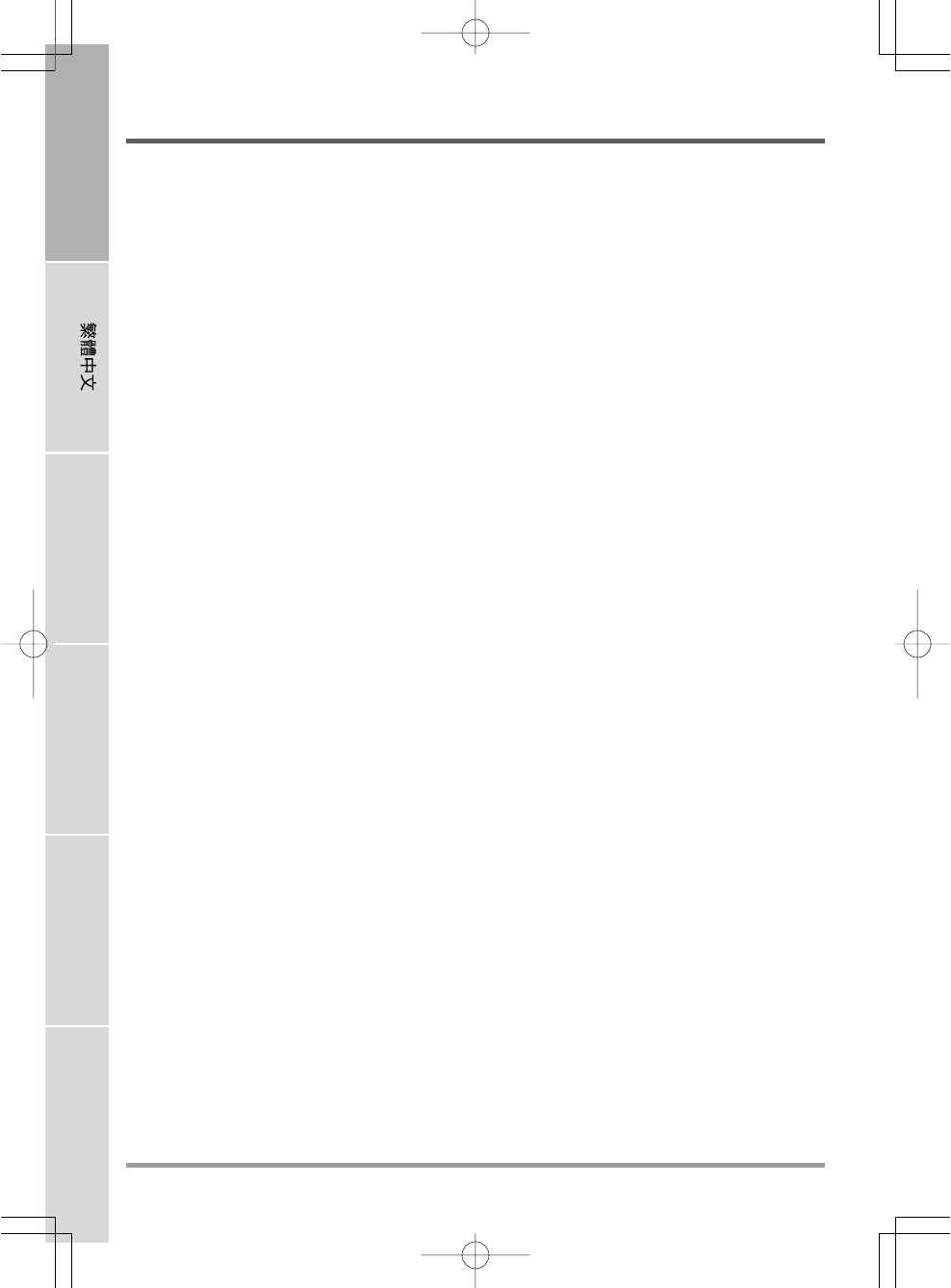
GETTING STARTED
18
ENGLISH FRANÇAIS DEUTSCH ESPAÑOL ITALIANO
Using Function Keys
Your computer has 12 function keys, F1 through F12. The functions assigned to these keys differ
for each application. You should refer to your software documentation to find out how these keys
are used.
The [FN] key provides extended functions for the notebook and is always used in conjunction
with another key.
• [FN+F1]: Places the notebook in Suspend mode. Pressing the Power button returns it to
active mode.
• [FN+F2]: Enables or disables the wireless network connection. Press this key combination
to enable Wireless LAN connection. Press and hold this key combination to enable 3G
network connection.
• [FN+F3]: Allows you to change your selection of where to send your display video. Each
time you press the combination of keys you will step to the next choice. The choices, in
order, are: built-in display panel only, both built-in display panel and external monitor, or
external monitor only.
• [FN+F4]: Decreases the screen Brightness.
• [FN+F5]: Increases the screen Brightness.
• [FN+F6]: Mutes the computer's volume.
• [FN+F7]: Decreases the computer's volume.
• [FN+F8]: Increases the computer's volume.
• [FN+F9]: Plays or pauses the current multimedia track.
• [FN+F10]: Stops the current multimedia track.
• [FN+F11]: Goes to the previous multimedia track.
• [FN+F12]: Goes to the next multimedia track.
• [FN+Esc]: Enables or disables the Bluetooth function.
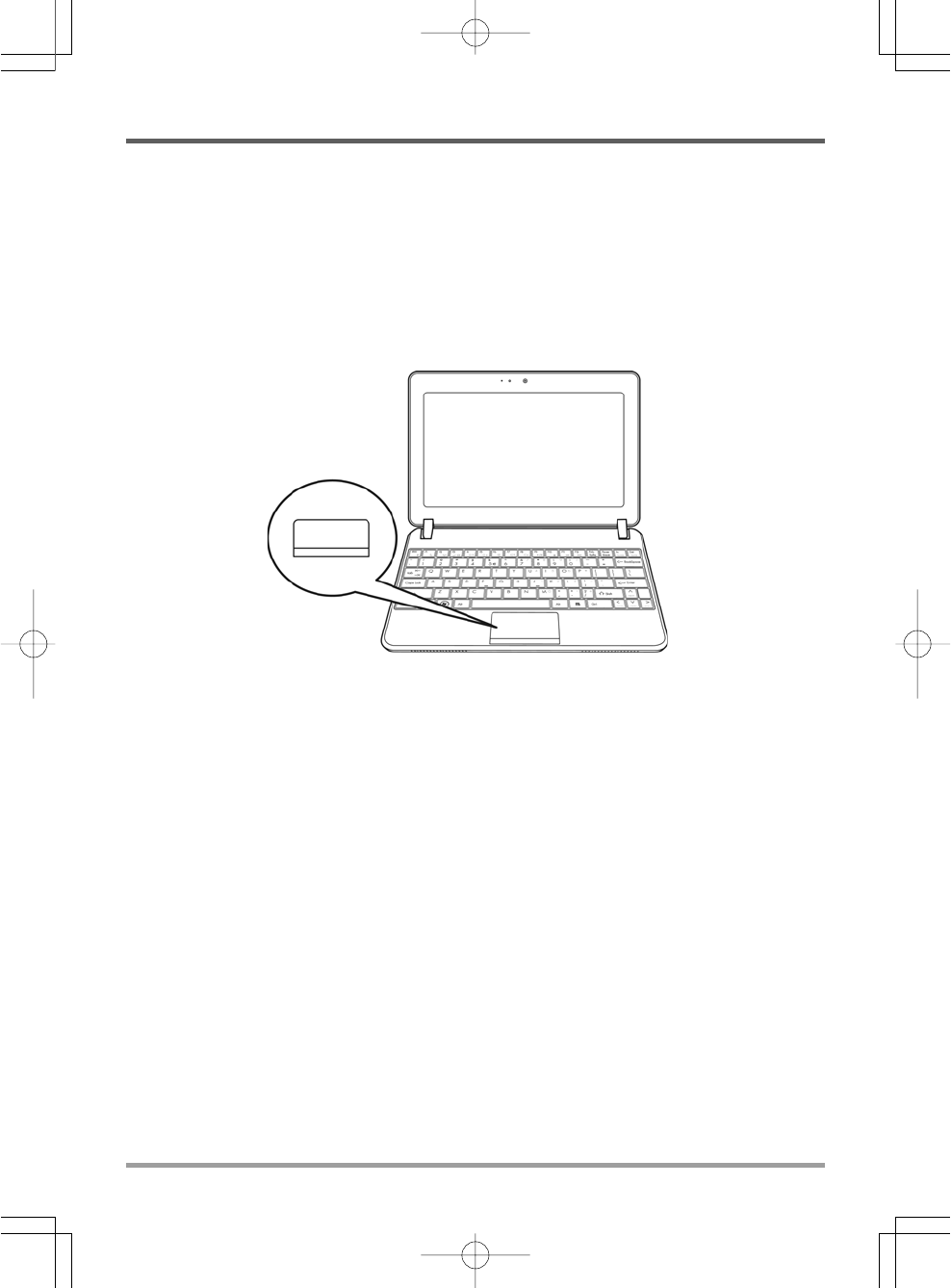
GETTING STARTED
19
Using the TouchPad
A TouchPad pointing device comes built into your computer. It is used to control the movement
of the pointer to select items on your display panel.
The TouchPad consists of a cursor control, a left button and a right button. The cursor control
works the same way a mouse does, and moves the cursor around the display. It only requires light
pressure from the tip of your finger. The left and right buttons function the same as mouse
buttons. The actual functionality of the buttons may vary depending on the application that is
being used.
Clicking
Clicking means pushing and releasing a button. To left-click, move the cursor to the item you wish
to select, press the left button once, and then immediately release it. To right click, move the
mouse cursor to the item you wish to select, press the right button once, and then immediately
release it. You also have the option to perform the clicking operation by tapping lightly on the
TouchPad once.
Double-Clicking
Double-clicking means pushing and releasing the left button twice in rapid succession. This
procedure does not function with the right button. To double-click, move the cursor to the item
you wish to select, press the left button twice, and then immediately release it. You also have the
option to perform the double-click operation by tapping lightly on the TouchPad twice.
Dragging
Dragging means pressing and holding the left button while moving the cursor. To drag, move the
cursor to the item you wish to move. Press and hold the left button while moving the item to its
new location and then release it. Dragging can also be done using the TouchPad. First, tap the
TouchPad twice over the item you wish to move, making sure to leave your finger on the pad after
the final tap. Next, move the object to its new location by moving your finger across the TouchPad,
and then release your finger.
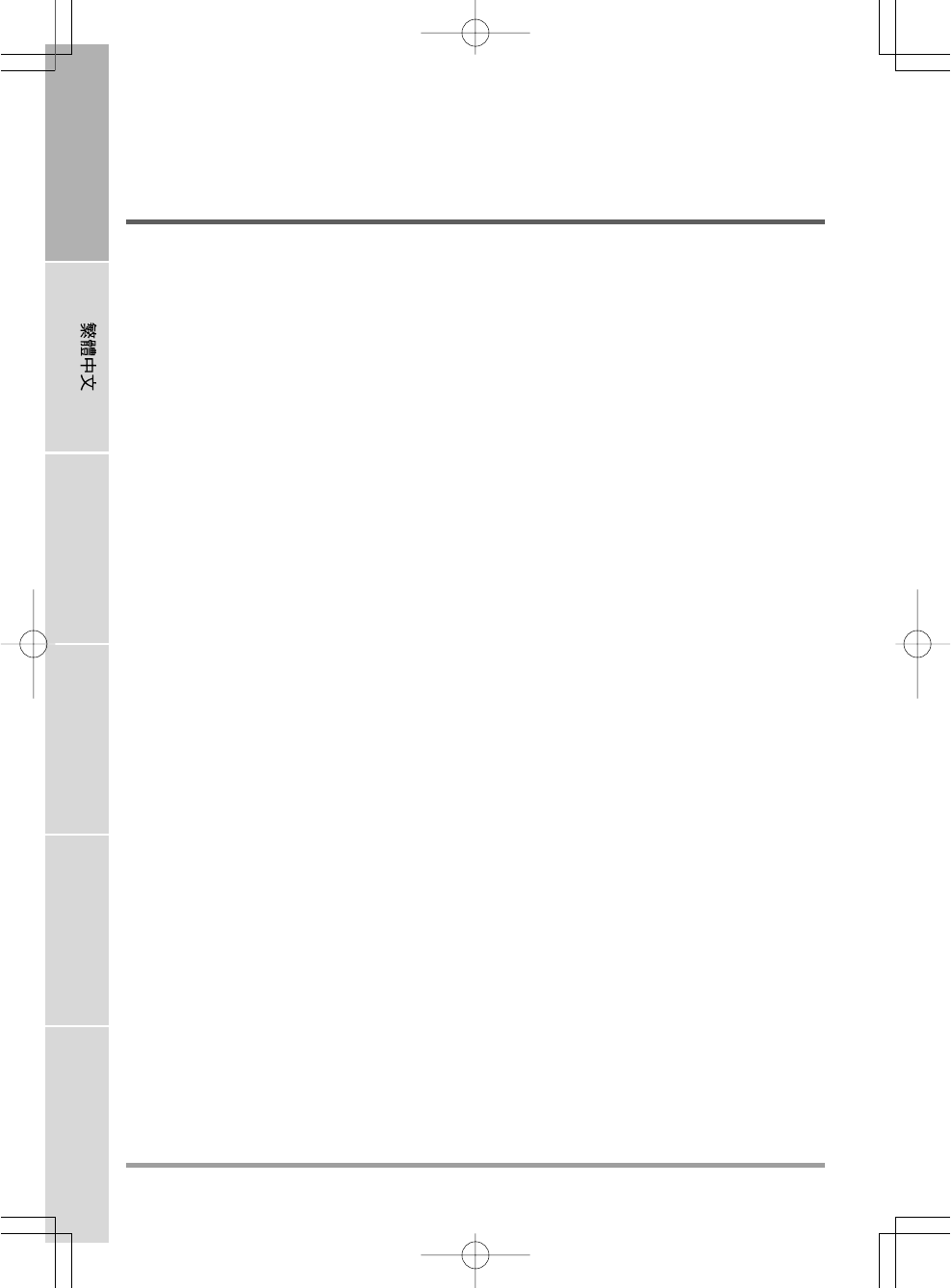
20
ENGLISH FRANÇAIS DEUTSCH ESPAÑOL ITALIANO
TROUBLESHOOTING
Your notebook PC is sturdy and subject to few problems in the field. However, you may encoun-
ter simple setup or operating problems that you can solve on the spot, or problems with periph-
eral devices, that you can solve by replacing the device. The information in this section helps you
isolate and resolve some of these straightforward problems and identify failures that require
service.
Identifying the Problem
If you encounter a problem, go through the following procedure before pursuing complex
troubleshooting:
1. Turn off your notebook.
2. Make sure the AC adapter is plugged into your notebook and to an active AC power source.
3. Make sure that any devices connected to the external connectors are plugged in properly. You
can also disconnect such devices, thus eliminating them as possible causes of failure.
4. Turn on your notebook. Make sure it has been off at least 10 seconds before you turn it on.
5. Go through the boot sequence.
6. If the problem has not been resolved, contact your support representative.
Before you place the call, you should have the following information ready so that the customer
support representative can provide you with the fastest possible solution:
• Product name
• Product configuration number
• Product serial number
• Purchase date
• Conditions under which the problem occurred
• Any error messages that have occurred
• Hardware configuration
• Type of device connected, if any
See the Configuration Label on the bottom of your notebook for configuration and serial numbers.

21
Copyright-protected technology
This product incorporates copyright protection technology that is protected by U.S. patents and
other intellectual property rights. Use of this copyright protection technology must be autho-
rized by Macrovision, and is intended for home and other limited viewing uses only unless
otherwise authorized by Macrovision. Reverse engineering or disassembly is prohibited.

MEMO
F
ederal Communications Commission (FCC) Statement
This device complies with Part 15 of the FCC Rules. Operation is subject to the following two
conditions:
(1)This device may not cause harmful interference.
(2)This device must accept any interference received, including interference that maycause
undesired operation.
Any changes or modifications (including the antennas) made to this device that are not expressly
approved by the manufacturer may void the user’s authority to operate the equipment.
FCC RF Radiation Exposure Statement: This equipment complies with FCC RF radiation
exposure limits set forth for an uncontrolled environment. This device and its antenna must not
b
e co-located or operating in conjunction with any other antenna or transmitter.
This equipment has been tested and found to comply with the limits for a class B digital device,
pursuant to part 15 of the FCC Rules. These limits are designed to provide reasonable protection
against harmful interference in a residential installation.
This equipment generates, uses and can radiate radio frequency energy and, if not installed and
used in accordance with the instructions, may cause harmful interference to radio
communications. However, there is no guarantee that interference will not occur in a particular
installation. If this equipment does cause harmful interference to radio or television reception,
which can be determined by turning the equipment off and on, the user is encouraged to try to
correct the interference by one or more of the following measures:
---Reorient or relocate the receiving antenna.
---Increase the separation between the equipment and receiver.
---Connect the equipment into an outlet on a circuit different from that to which the receiver is
connected.
---Consult the dealer or an experienced radio/TV technician for help.
FCC RF Radiation Exposure Statement:
1.This Transmitter must not be co-located or operating in conjunction with any other antenna or
transmitter.
2.This equipment complies with FCC RF radiation exposure limits set forth for an uncontrolled
environment. To maintain compliance with FCC RF exposure compliance requirements, avoid
direct contact to the transmitting antenna during transmitting.